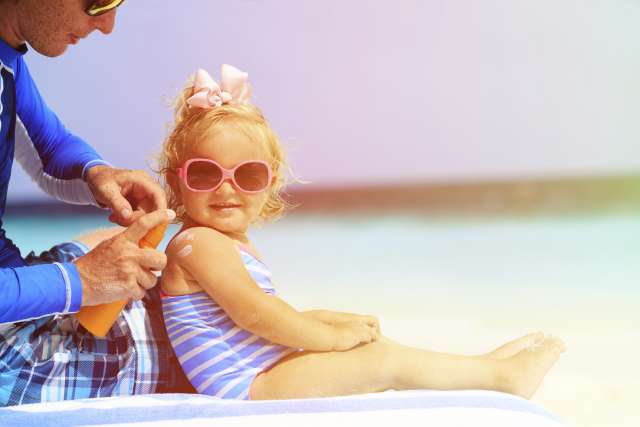With summer approaching, it is important for families and caregivers to learn about and practice safe skin behaviors.
We spoke with Carol Cheng, MD, a UCLA Health board-certified pediatric dermatologist, on what to look out for and how to keep your children’s skin safe this summer.
Q: What are your recommendations for sun safety for infants up to adolescence?
A: The first and most effective line of defense against getting sunburned, is to seek out shade. Second is to use sun protective clothing, such as wide-brimmed hats, long sleeve clothing, rash guards, and sunglasses. The third line of defense is applying a broad-spectrum sunscreen with sun protection factor (SPF) of 30 or greater.
For children under six months, the American Academy of Pediatrics (AAP) recommends avoiding direct sunlight and providing shade – either with an umbrella or under the canopy of their stroller and using sun protective clothing. Ideally, sunscreen use should be avoided in babies younger than 6 months old. However, if this is not possible, a mineral-based sunscreen can be applied in areas that are unable to be shaded or covered by clothing.
It is helpful to familiarize yourself with reading a sunscreen label. There are four main components.
- Broad spectrum: This means the sunscreen offers effective protection against both ultraviolet A (UVA) and ultraviolet B (UVB) rays, which can cause damage to the skin and lead to skin cancer
- SPF: The SPF number tells you the amount of time it would take for the sun’s UV radiation to produce redness or burned skin when using the sunscreen compared with the amount of time without using sunscreen. For example, if a person without sunscreen were to get burned in 10 minutes, applying a SPF 30 sunscreen means it would take 30 times as long to get burn, if using the sunscreen correctly
- Water resistant: The terms “water/sweat resistant” indicate whether the sunscreen is effective when used while sweating or swimming. There are no “waterproof” sunscreens
- Active ingredient(s): These are the ingredients in sunscreens that protect your skin against UV rays. There are two main types of sunscreen ingredients: chemical and physical. Chemical ingredients, such as avobenzone, work by absorbing UV, and physical ingredients, such as zinc oxide, stay on top of the skin and deflect UV rays.
Dr. Cheng says she and other pediatric dermatologists recommend using physical ingredients, also known as mineral sunscreens, which contain either zinc oxide or titanium dioxide for infants and younger children, which minimize irritation on sensitive skin.
“We recommend using a broad spectrum sunscreen with SPF 30 or greater,” she says. “Our general recommendation is to reapply every two hours of continuous time in the sun. If your child goes in the water or is sweating, use a water-resistant sunscreen and reapply after being in the water.”
Dr. Cheng notes that data from the American Academy of Dermatology show that sunscreen protects us from developing skin cancer and that even one blistering sunburn in childhood can double the risk of melanoma in adulthood.
Q: What can be done if your child still gets a sunburn?
A: Apply a cold compress or take a cool bath. Aloe vera can also be helpful. Over-the-counter hydrocortisone 1% cream can also be helpful to ease red, itchy or tender skin and help with inflammation. If the sunburn is really painful or widespread, please discuss with your physician if taking ibuprofen is appropriate for older children. If you notice any blistering, please see a pediatric dermatologist.
Q: How do you spot heat rash and what can you do about it?
A: Heat rash happens when the sweat ducts or sweat glands are blocked. They typically present with small, itchy, pink to red bumps on the skin, especially in areas where the skin is occluded. For example, on a hot day, a baby sitting in the car seat during a long drive might get affected with a heat rash on their back, because they're sweating in that area for a long time.
To prevent heat rash on hot days, try to avoid intense heat for long periods of time and aim for cooler places or places that are air conditioned. Consider bringing a portable fan to prevent overheating in strollers. Wearing loose fitting, lightweight, and breathable clothing, such as ones made of cotton are also helpful. When planning outdoor activities, try to plan it during the cooler part of the day and not between 10am - 2pm, where the sun tends to be the hottest. And lastly, when at home, keep the air conditioner or fan on if possible to prevent heat rash.
Q: Is there any guidance for post-pool skincare?
A: Some people may be more sensitive to developing dry skin when exposed to chlorinated water. We recommend rinsing off thoroughly with cool to warm water after getting out of the pool with a gentle soap to remove chlorine or salt from the body, which can cause irritation to the skin. Then apply a bland, fragrance-free moisturizer to rehydrate the skin. This is especially important for people who swim frequently or have skin sensitive conditions such as eczema.
Other year-round skin-related conditions that appear more frequently during the summer include bug bites, warts, poison oak dermatitis, athlete’s feet and blisters.
General advice from Dr. Cheng includes:
- Practice good hygiene after using public areas such as pools and play gyms
- Minimize going barefoot in public areas to prevent infections from viruses such as warts and fungus
- Over the counter medications with salicylic acid may help for warts – or contact your pediatrician or dermatologist
- Over the counter hydrocortisone can help with bug bites and poison oak, although sometimes a stronger prescription may be needed
- If your child is experiencing a sunburn that is blistering, not improving within a week, is in significant pain, or has systemic symptoms, call your pediatrician or dermatologist




